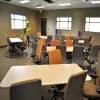It was a day of smart talk when nine industry bigwigs came together in Mumbai to deliberate upon aspects that contribute towards creating a smart workplace.
The roundtable discussion, organised by CW, revolved around factors that set these workplaces apart; the roles that design and technology play in the quest to smarten up and get sharp; and their impact on productivity and performance.
Creating and sustaining great workplaces for employees is paramount for any organisation to achieve long-term success.
Arvind Nandan, Director-Valuation & Advisory Services, South Asia, Colliers International, and moderator of the CW roundtable discussion, opened the conversation saying, 'Design of spaces is often thought of in terms of the form, flow of spaces, mixing and clustering of areas, etc. But modern times are witnessing a huge amount of automation and play of technology.' He questioned: What factors come into play to make workplace as smart?
Planning smart
Citing the example of a project recently executed by his firm, Shresht K Kashyap, Director, KNS Architects, said, 'It was a heritage building in Mumbai in a densely populated area with buildings on either side and hence, no ventilation. We created a skylight on the roof. And in areas where we could not manage natural light, we created artificial windows with a fitting that can be programmed to give light as per the time of the day.' So in this project, technology was used to create an environment that could enhance employee productivity.
Milind Pai, Chief Architect, Milind Pai Architects & Interior Designers, broadly categorised smart workplaces into areas such as 'Thermal control as for air-conditioning, lighting and security,' which can all be integrated together. 'We talk about green materials and how to save resources using diligent technologies,' he said.
Similar to the concept of circadian rhythm, related to the cycle of sunlight and daylight, there is a concept of biophilia, which talks about connecting with nature. 'These are aspects that we bring into our designs.' Pai also mentioned chromo therapy in lighting, different colours having different vibrations, the need to control noise, etc.
To this, Sukanto Aich, Senior Director-Lighting, Philips Lighting India, stated the importance of conducting research to understand "how light impacts employee productivity in a workplace." He shared a thought: 'If I need to fit a light in a noisy area, can it be made with a material that absorbs sound?
This is how we try to make spaces smarter, which makes sense for the employee in the office.' Philips Lighting India has two research labs, in Noida and Bengaluru. While the Noida lab works towards making lighting healthy and productive for the workspace, the Bengaluru lab oversees the connectivity aspect. 'One can also have a sensor that switches off the light and the air-conditioning at the same time, saving more power. Additionally, lights equipped with sensors can also enable optimal utilisation of office space by monitoring occupancy on a real-time basis.'
If an office is designed for about 2,000 employees, at any given point in time, this space will not be completely occupied. A sensor can be installed to detect people and analyse the amount of space being utilised. So, in the following year, if HR plans to add 500 people (potentially also adding 500 more workstations), data would reveal that only 30 per cent of the space is utilised and there is no need for additional workstations. Hence, Aich said, 'Be it the HVAC system, building management system or the whole IT system from which analytics can happen, all of it can be connected.'
Trending!
With the growing need for smart offices, smart features are coming into play as well. As Mahesh Mudda, Managing Director, New Consolidated Construction Company, said, 'We have been building offices for over three decades and there has been a total change in approach. There have been advancements right from flooring materials to partitions to false ceilings, lighting, HVAC, etc. The focus is also on encouraging natural light, ensuring minimum utilisation of air-conditioning, and offering comfort to employees. The ultimate motive is employee productivity.'
And Puja M Dattatraya, LEED
AP Director Head-Corporate Interior Projects, West Project Management Group, CBRE South Asia, said, 'India has one of the youngest demographics. So, at a workplace, retention is a key issue - hence, the need for an employee to get engaged and have a sense of belonging.' Here, she added that the one-off approach could not just be limited to creating a fancy office space.
'It needs to deliver to the employees. Open offices mean getting more density, and more people can be accommodated. In exchange, create more amenities and collaborative spaces...along with trends like LEED certifications, sustainability, etc.'
Prathamesh Khandekar, Associate Director, Vector Projects (India), agrees to optimisation being the key. 'Companies have been designing office spaces for multi-use,' he said. 'We are seeing reduction in dedicated workplaces.' He elaborated through the example of an office space done by Vector Projects. The employee walks in, there would be a sort of console, and they could select their space for the day depending on the kind of work they would be doing - an interactive zone for an interactive job or a focus zone for a research job. 'So, we have been trying to make offices adaptive and open to reconfiguration by users.' Reconfiguration could have the scope to become a huge trend with users having the opportunity to define their own space.
Truly smart
How does one determine what is actually intelligent?
Anil Jaggia, COO, Avendus Capital, put forth two dimensions to smart: 'Employee productivity and cost-efficiency.' He said, 'In a workplace, you can fit in as many people as you want to, but by design one can create more space or illusion of space.' Illusion of space can be more important than the space itself. Further, Jaggia also pointed out how the most understated loss in productivity comes from sound in a workplace. Hence, being smart on handling sound is critical. He referred to another crucial element being ergonomics. A smart office should offer the flexibility to move your desk up and down, with the convenience of sitting or standing space as desired.
Accenture, which has 140,000 employees across different cities, has been retrofitting its existing offices in India to replace their conventional lighting with LED, and Philips Lighting has been their main supplier. Applauding the work done by Philips, Rohan Ajgaonkar, General Manager-Accenture Workplace, Accenture, said, 'When we talk of designing offices, the sky is the limit. And being an IT company, we got excellent results on employee engagement just by changing the light fixtures.'
Aich also added the example of light fixtures installed for a large IT company in Bengaluru, 'where the lighting fixture does not even have an electrical wire, and from a usage perspective, it is actually linked to a Cisco switch on an Ethernet'.
In terms of materials, the biggest evolution has been in acoustic materials. 'This needs to be intelligently used within an office space to create smaller pockets,' said Khandekar. 'Today, even full height, movable acoustic panels are used to control ambient noise.'
The RoI in smart
Return on Investment (RoI) is certainly a driving factor in planning any space. ôBe it even a green-certified workplace, what matters is how the business would look at it in terms of long-term advantages,' said Ajgaonkar. 'While monetary advantage is one of the dominant parameters, companies like ours also consider carbon footprint and others.' On cost-efficiency, Jaggia said, 'Capex (capital expenditure) is not to be ignored; if we get the opex (operational expenditure) right, the willingness to spend will be more.' To this, Aich added, 'To give a thumb rule, for most LED lights today - if you have about a 12-hour operation outside daylight hours - the payback would be one-and-a-half to two years, depending on the factors being put in.'
Today in India, a lot of office space is occupied by BPO and IT companies. They measure productivity in terms of number of calls being made by employees or number of reductions in errors.
'So first we had to prove that lighting itself will pay over a one-and-a-half year period,' explained Aich. 'Then we added that if the light generated an electricity bill of Rs 1,000 a year, we could offer 60 per cent savings.
But if this employee generates $1,000 revenue, which is Rs 75,000, and with lights, if I am able to influence a productivity increase of 2 to 6 per cent, the amount of money that the company would generate would be much larger than the 60 per cent savings on the electricity bill.' With this, the company convinced its customers about the investment making sense.
And highlighting other aspects that lead to smart savings, Dattatraya said, 'Waterless urinals and ensuring water is on sensors, putting sensors on lights and having LED versus the traditional, are incremental changes that will lead to a lot of savings. We have done that quite successfully with almost 7-10 per cent savings upfront and potential savings of opex down the road.'
The Round-Up
Sukanto Aich, Senior Director-Lighting, Philips Lighting India
'In the workplace today, especially in India, we have large office spaces catering to the IT and BPO industries who work late hours, round the clock. While lighting can help the productivity of the employee, it is also important to see how this can be achieved with the least amount of energy. With LED coming in, lighting energy consumption has gone down by 50 per cent. At times, common areas do not require lights all the time. So, we are now combining LED technology and smart lighting to offer a much larger energy saving potential and making the whole environment green.'
Rohan Ajgaonkar, General Manager-Accenture Workplace, Accenture
'Workplace is about humans, and it is in human nature that we all love transparency. So, light and air, the way workstations or workplaces are designed, more openness in the environment...they all definitely percolate down to productivity. And this need not always be productivity on the floor - in general, it's the body language, the enthusiasm one feels. And that is what actually matters.'
Shresht K Kashyap, Director, KNS Architects
'Some time ago, we did an office building in Mumbai. The problem was that there was no natural light coming in. We suggested actually breaking up the entire slab on the terrace and creating a skylight all the way down to the bottom. The clients agreed because, at the end of the day, they realised that if the environment was not conducive for people to work, there would be a problem in the eventual result.'
Arvind Nandan, Director-Valuation & Advisory Services, South Asia, Colliers International
'Several changes have been taking place in workplaces right from design to services such as lighting, HVAC and use of materials and systems. Today, offices are being configured keeping conference spaces in between other spaces. At the same time, technology is changing the way office spaces are being used. One example is the use of intelligent lighting. In some cases, the air-conditioning and lighting are linked and they work together only when they are being used; when not in use, there is general illumination.'
Prathamesh Khandekar, Associate Director, Vector Projects (India)
'There are two levels to productivity: One of employees, and two of the organisation itself. Making a smart workspace would result in a lot of savings for the company in terms of smart lighting and HVAC, and having reconfigurable spaces. As for employees, a smart office is all about incorporating user-friendly technology that will help them reconfigure their workspace. It's about having furniture and chairs that can be easily configured to suit the daily routine.'
Puja M Dattatraya, LEED AP Director Head-Corporate Interior Projects, West Project Management Group, CBRE South Asia
'The trend started with a lot of enclosed offices becoming open to increase collaboration. Another trend in a smart workplace is smart lighting - ensuring there are occupancy sensors to determine the right kind of light required, leading to employee productivity. These features are easy to adopt, including being intelligent about water, with waterless urinals and basins. These not only offer returns to owners, but enhance productivity in the firm.'
Milind Pai, Chief Architect, Milind Pai Architects & Interior Designers
'For any organisation, the employee is the most important asset. Smart offices and automation are some of the areas crucial for employee well-being. There are various areas in which smart technology can be applied - one is temperature control. If a person is working in an uncomfortable situation, productivity goes down. So, we use principles such as temperature, lighting, use of colours and connecting the office's interior to the exterior nature, as well as the ergonomics of the structure.'
Mahesh Mudda, Managing Director, NCCCL
'Today, there is a huge advancement in lighting in workplaces. Also for HVAC, we have air-conditioners with zero noise level, which provides comfort while working. The concept of the open office, where people interact with each other, is trending.'
Anil Jaggia, COO, Avendus Capital
'A smart workplace basically improves productivity on aspects of sound, light, heat, ergonomics and many more. Space is always looked at horizontally, but the most ignored facet of space is looking at it vertically. Also, when you talk of employee productivity, one does not want to be boxed in if there is space.'
- SHRIYAL SETHUMADHAVAN
To share your views on this article, write in at feedback@ConstructionWorld.in


















